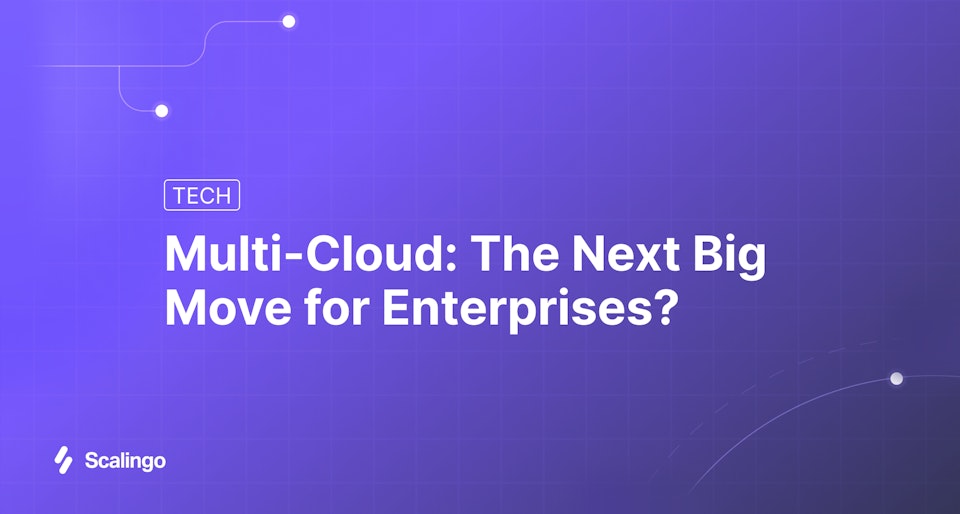Multi-Cloud: The Next Big Move for Enterprises?

At Scalingo, we see multi-cloud gaining ground every day. More and more enterprises are bringing us into their cloud architecture as a second provider, typically alongside some of the biggest US hyperscalers.
It usually starts small: a side project, an app run by a subsidiary, a regional business unit’s platform, or a lower-stakes service within a global enterprise. Safe places to experiment without touching critical operations. But these trials grow quickly and become strategic programs, accounting for an ever larger share of deployments.
The driver is clear: avoiding single-vendor dependence. Tech lock-in, regulatory pressure, geopolitics, major outages...the risks are real.
That’s why diversifying cloud partners is no longer theoretical. It’s a concrete choice many large companies make to stay in control and reduce exposure, while giving a welcome boost (🙌) to the European tech ecosystem.
The case for multi-cloud
Relying on a single provider once felt safe: a familiar stack, trained teams, one point of contact. On paper, it looks tidy.
In practice, needs evolve. Prices shift, regulations tighten, latency or data-residency requirements appear, outages happen, and that dependence turns from convenience into constraint.
Multi-cloud helps avoid the trap. You place each workload or project where it makes the most sense, optimizing for performance, cost, and data locality, so you can tap each provider’s strengths without getting boxed into a single ecosystem. By favoring open standards and portable architectures, you keep the option to move when you need to.
The result is control: more room to negotiate and adapt, stronger continuity under stress, and the freedom to move fast without surrendering sovereignty over your architecture and data.
Backing French Tech and the European ecosystem 🇪🇺
Choosing cloud providers is no longer just a technical call; it’s become a strategic and even ethical one. Working with European providers, alongside, or where it makes sense, instead of the US hyperscalers, sends a clear signal to customers and partners: a concrete commitment to technological sovereignty, data protection, and long-term autonomy.
Most European cloud providers now deliver high-performance, competitive alternatives. Integrating them into a multi-cloud strategy not only diversifies your architecture but also reinforces the broader ecosystem: every workload entrusted to local players fuels innovation, nurtures competition, and helps Europe stand as a credible counterweight in a market otherwise dominated by a few global giants. Now that’s future-proofing!
Anticipating regulatory change
Rules governing data are also tightening. GDPR set the baseline, and French national schemes such as HDS (for health data hosting) and SecNumCloud (the French cybersecurity label for trusted cloud services) already impose strict requirements on providers.
At the European level, initiatives like Gaia-X and the proposed EUCS (European Union Cybersecurity Certification Scheme for Cloud Services) aim to extend these principles across borders, reinforcing digital sovereignty and reducing exposure to extraterritorial laws like the U.S. CLOUD Act.
For large enterprises, non-compliance can carry penalties of up to €20 million or 4% of worldwide annual turnover, consequences that are hard to ignore.
European providers typically offer greater transparency around data handling and data residency, which helps limit exposure to foreign legal reach. By diversifying cloud partners, large enterprises can shield themselves from these constraints and plan for future regulatory shifts with confidence.
Testing and learning through secondary projects
Satellite or subsidiary-led projects are ideal proving grounds to experiment without putting critical operations at risk. They let teams trial different configurations, understand each provider’s nuances, and codify best practices before any broader rollout.
A small pilot, such as an internal app or a lower-stakes service, can serve as a sandbox to verify compatibility with European solutions, validate cost controls, and strengthen redundancy. This staged approach limits the risks of big-bang migrations and lays solid foundations for more ambitious deployments.
Ready to get started?
Every company’s journey to multi-cloud looks a little different. Maybe it starts with a single app, maybe with a compliance need, maybe with the desire to back European tech. What matters is making the first move with confidence.
If you’re wondering how a European partner can fit into your cloud strategy, let’s talk. We’d be glad to share what we’ve seen work for other companies and help you shape your own path.



